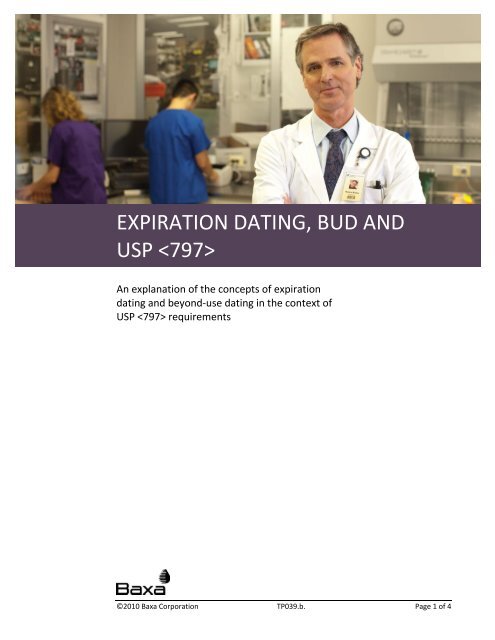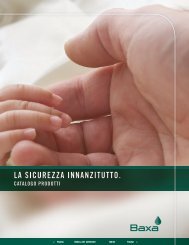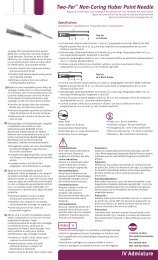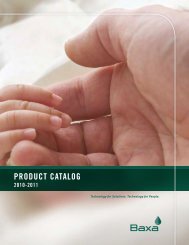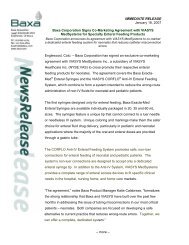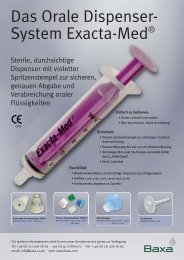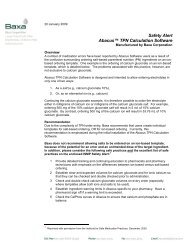Expiration Dating, BUD and USP - Baxa
Expiration Dating, BUD and USP - Baxa
Expiration Dating, BUD and USP - Baxa
Create successful ePaper yourself
Turn your PDF publications into a flip-book with our unique Google optimized e-Paper software.
EXPIRATION DATING, <strong>BUD</strong> AND<br />
<strong>USP</strong> <br />
An explanation of the concepts of expiration<br />
dating <strong>and</strong> beyond-use dating in the context of<br />
<strong>USP</strong> requirements<br />
©2010 <strong>Baxa</strong> Corporation TP039.b. Page 1 of 4
EXECUTIVE SUMMARY<br />
With the release of the United States Pharmacopeia (<strong>USP</strong>) Chapter a new ‘language’ was<br />
created for pharmacy pertaining to sterile compounding <strong>and</strong> the requirements for testing <strong>and</strong><br />
labeling compounded sterile products (CSPs). This paper reviews the differences between<br />
expiration dates <strong>and</strong> beyond-use dates for health-system pharmacies in the context of the<br />
revised <strong>USP</strong> requirements.<br />
An expiration date is the date beyond which ideally stored medications in the unopened<br />
manufacturer’s storage container – or in most circumstances – the opened, intact<br />
manufacturer’s storage container should not be used.<br />
A beyond-use date (<strong>BUD</strong>) is the date beyond which medications that have been manipulated<br />
<strong>and</strong>/or repackaged <strong>and</strong> stored or dispensed in a container other than the original<br />
manufacturer’s storage container should not be used.<br />
OVERVIEW: THE TERMS AND THEIR PRACTICAL USE<br />
The expiration date <strong>and</strong> beyond use date (<strong>BUD</strong>) are two very different things. <strong>USP</strong> defines the<br />
expiration date as "the time during which the article may be expected to meet the<br />
requirements of the pharmacopeial monograph provided it is kept under the prescribed<br />
conditions." 1 The expiration date, which limits the time during which the article may be<br />
dispensed or used, is based on scientifically sound stability studies carried out by the<br />
manufacturer <strong>and</strong> is usually expressed in terms of a month <strong>and</strong> year as stated on the labeling<br />
on the manufacturer's container. This means that the product can be used or dispensed until<br />
the last day of the stated month <strong>and</strong> year, if any indicated storage <strong>and</strong> h<strong>and</strong>ling requirements<br />
have been met.<br />
Within the health-system pharmacy, pharmacists are required to affix beyond-use dates – not<br />
expiration dates – to prescriptions <strong>and</strong> repackaged vials that are h<strong>and</strong>led <strong>and</strong>/or compounded<br />
<strong>and</strong> sent to the patient for administration. Beyond-use dates account for the fact that the<br />
manufacturer's original container has been opened in the aseptic manipulation process,<br />
thereby exposing the pharmaceutical article to ambient atmospheric conditions <strong>and</strong> touch<br />
contamination. This exposure, <strong>and</strong> the fact that containers into which dosage forms are<br />
repackaged may not have the integrity of the original package, necessitates a shortening of the<br />
expiration period from that originally set by the manufacturer. The appropriate terminology to<br />
be used on these “repackaged” drug prescription labels is "Beyond-Use Date." The use of the<br />
term "expiration date" for a dispensed prescription is not correct.<br />
©2010 <strong>Baxa</strong> Corporation TP039.b. Page 2 of 4
Application of the beyond-use date is essential for dose safety, because it defines an<br />
appropriate period of time during which a prescription drug may be administered to a patient<br />
by a healthcare worker [inpatient scenario] or retained by a patient after it is dispensed<br />
[outpatient scenario]. This beyond-use date takes into account various factors, such as the<br />
nature of the drug being dispensed (i.e., chemical stability, if preservatives are present <strong>and</strong><br />
concentrations of preservative if present), type of storage containers, microbiological limits,<br />
environmental storage conditions (i.e., room, refrigerated, freezing temperatures as well as<br />
moisture conditions, <strong>and</strong> especially the frequent opening of the package. These factors provide<br />
the rationale for requiring a limited beyond-use date.<br />
There are, however, exceptions to these specific limits, including medications that are<br />
reconstituted before use; medications that have special beyond-use dates from the<br />
manufacturer (i.e., the manufacturer tested the stability of the medication after initial entry<br />
into the container); medications with special concerns that require limited beyond-use dates<br />
from the manufacturer; or when proper, sound <strong>and</strong> scientific “post-marketing” stability studies<br />
have been conducted.<br />
APPLICATION OF <strong>BUD</strong> IN PHARMACY PRACTICE<br />
<strong>USP</strong> sets forth clear guidelines for the maximum <strong>BUD</strong>s for doses that are high, medium<br />
<strong>and</strong> low risk compounding activities. 2<br />
Risk Category Room Temp Refrigerator Freezer<br />
Immediate Use 1 hour 1 hour N/A<br />
Low 48 hours 14 days 45 days<br />
Low w/12-hr <strong>BUD</strong> 12 hours or less 12 hours or less N/A<br />
Medium 30 hours 9 days 45 days<br />
High 24 hours 3 days 45 days<br />
Frequently, pharmacies have questions regarding the practical usage of <strong>BUD</strong>s on specific<br />
compounding <strong>and</strong> sterile fill applications within their practice. Others question the application<br />
of <strong>Baxa</strong> products as related to <strong>BUD</strong>s. A few of these frequently asked questions are reviewed<br />
below.<br />
Sterile filling of saline flushes. As a medium-risk activity, flushes would have a maximum<br />
refrigerated <strong>BUD</strong> of 9 days (under the revised Chapter ). If, in their professional opinion,<br />
pharmacists determine that the process of filling saline flushes is a low-risk activity, that dating<br />
is extended to 14 days as a refrigerated dose. This decision is subject to professional debate<br />
<strong>and</strong> can be argued either way. <strong>USP</strong> is not prescriptive for these decisions, but rather<br />
leaves the interpretation to the judgment of pharmacy professionals.<br />
Cefazolin. Again, compounding one-gram doses of cefazolin can be categorized as either low<br />
risk or medium risk. In this case, there is less debate because of the reconstitution step<br />
required. For a single dose preparation, the maximum refrigerated <strong>BUD</strong> is 14 days, if the other<br />
factors (e.g., drug stability, etc.) support such a designation. Batch-prepared cefazolin doses<br />
use multiple vials, clearly a medium-risk activity. Once again though, these <strong>USP</strong> 797 guidelines<br />
are for maximum <strong>BUD</strong>’s within activity levels <strong>and</strong> not absolutes.<br />
©2010 <strong>Baxa</strong> Corporation TP039.b. Page 3 of 4
End-product sterility testing. It’s possible to exp<strong>and</strong> beyond-use dates through a scientifically<br />
proven <strong>and</strong> valid protocol with a particular product <strong>and</strong> process to determine that the product<br />
remains stable <strong>and</strong> sterile for periods exceeding the “maximum” default <strong>BUD</strong> times for the<br />
process categories (outlined above). However, the process m<strong>and</strong>ated under <strong>USP</strong> can be<br />
onerous for individual pharmacies, <strong>and</strong> even for manufacturers. Few pharmacies have the<br />
internal resources to meet such a high st<strong>and</strong>ard for protocol development <strong>and</strong> validation<br />
testing, or the resources to outsource these activities.<br />
<strong>Baxa</strong> automation. <strong>Baxa</strong> products are not critical factors in setting product <strong>BUD</strong>. The RapidFill<br />
Automated Syringe Filler (ASF) <strong>and</strong> IntelliFill® i.v. offer the means to reduce the opportunity for<br />
touch contamination in sterile compounding <strong>and</strong> may be rationalized as providing a low-risk<br />
means for batch sterile saline flushes <strong>and</strong> antibiotics. However, end-product testing is<br />
recommended to verify process capability <strong>and</strong> product sterility. To justify extending beyonduse<br />
dating with the <strong>Baxa</strong> RapidFill ASF or the IntelliFill i.v. requires undertaking the testing<br />
m<strong>and</strong>ated under <strong>USP</strong> for end-product sterility testing.<br />
Guidelines for setting <strong>BUD</strong> There is no simple answer or “ultimate source” for guidelines in<br />
setting <strong>BUD</strong>. To investigate the possibility of extending the <strong>BUD</strong> guidelines set forth under <strong>USP</strong><br />
, one place to start is with the scientific information provided in Trissel’s H<strong>and</strong>book on<br />
Injectable Drugs 3 , then consider any intangibles related to your sterile compounding process,<br />
environment <strong>and</strong> personnel. While the <strong>USP</strong> guidelines for extending <strong>BUD</strong>s represent a<br />
body of work for validation, a well-run pharmacy service can manage the process with time <strong>and</strong><br />
resources without significant investment.<br />
SUMMARY<br />
As with other guidelines under <strong>USP</strong> , the intent is to provide a means for addressing<br />
issues with sterile compounding, <strong>and</strong> to provide an appropriate means for addressing identified<br />
safety issues.<br />
For CSP’s, the beyond-use date is intended to identify the interval from the time of preparation<br />
(mixing) to the time where the preparation can be safely used – that is, before it is at risk for<br />
chemical degradation, contamination <strong>and</strong>/or packaging permeability. Beyond-use dates notify<br />
pharmacists <strong>and</strong> caregivers of the date after which a CSP should not be administered.<br />
REFERENCES<br />
1.<br />
<strong>USP</strong> Chapter . 2008 August.<br />
2.<br />
E. Kastango, STAR Center presentation, <strong>USP</strong> Chapter Pharmaceutical Compounding-Sterile Preparations,<br />
January 2008.<br />
3.<br />
Trissel, Lawrence A. H<strong>and</strong>book on Injectable Drugs. 14 Rev Ed. American Society of Health-System<br />
Pharmacists. 2006.<br />
©2010 <strong>Baxa</strong> Corporation TP039.b. Page 4 of 4


